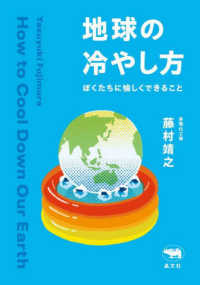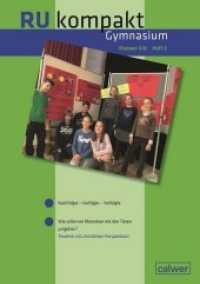- ホーム
- > 洋書
- > 英文書
- > History / World
Full Description
In recent years, there has been an increasing interest in Early Modern Festivals. These spectacles articulated the self-image of ruling elites and played out the tensions of the diverse social strata. Responding to the growing academic interest in festivals this volume focuses on the early modern Iberian world, in particular the spectacles staged by and for the Spanish Habsburgs. The study of early modern Iberian festival culture in Europe and the wider world is surprisingly limited compared to the published works devoted to other kingdoms at the time. There is a clear need for scholarly publications to examine festivals as a vehicle for the presence of Spanish culture beyond territorial boundaries. The present books responds to this shortcoming. Festivals and ceremonials played a major role in the Spanish world; through them local identities as well as a common Spanish culture made their presence manifest within and beyond the peninsula through ephemeral displays, music and print. Local communities often conflated their symbols of identity with religious images and representations of the Spanish monarchy. The festivals (fiestas in Spanish) materialized the presence of the Spanish diaspora in other European realms. Royal funerals and proclamations served to establish kingly presence in distant and not so distant lands. The socio-political, religious and cultural nuances that were an intrinsic part of the territories of the empire were magnified and celebrated in the Spanish festivals in Europe, Iberia and overseas viceroyalties. Following a foreword and an introduction the remaining 12 chapters are divided up into four sections. The first explores Habsburg Visual culture at court and its relationship with the creation of a language of triumph and the use of tapestries in festivals. The second part examines triumphal entries in Madrid, Lisbon, Cremona, Milan, Pavia and the New World; the third deals with the relationship between religion and the empire through the examination of royal funerals, hagiography and calendric celebrations. The fourth part of the book explores cultural, artistic and musical exchange in Naples and Rome. Taken together these essays contribute further to our growing appreciation of the importance of early-modern festival culture in general, and their significance in the world of the Spanish Habsburgs in particular.
Contents
Foreword, Teófilo F. Ruiz; Introduction. Part I Habsburg Visual Culture: Tapestries, Paintings and Festivals at Court: The language of triumph: images of war and victory in two early modern tapestry series, Fernando Checa Cremades; The ceremonial decoration of the Alcázar in Madrid: the use of tapestries and paintings in Habsburg festivities, Miguel A. Zalama Rodríguez. Part II Entries, Sojourns and the Wider Triumphal Culture in the Habsburg World: Festival interventions in the urban space of Habsburg Madrid, David Sánchez Cano; Negotiating terms: King Philip I of Portugal and the ceremonial entry of 1581 into Lisbon, Laura Fernández-González; The loose parts of an entry: the flop of Cremona in 1598, Maria Ines Aliverti; Margaret of Austria's travel in the state of Milan between 1598 and 1599, Franca Varallo; Routes and triumphs of Habsburg power in colonial America, Victor Mínguez Cornelles. Part III Religion and Empire: Processions, Funerals and the Spanish Monarchy: The ceremonial king: kingly rituals and imperial power in 17th-century New World cities, Alejandra B. Osorio; Festivals and hagiography in the Spanish court (1565-1615), Juan Luis González García; Corpus Christi in Spanish Palermo: two baroque apparati by Giacomo Amato for the Duke of Uceda (Viceroy of Sicily, 1687-1696), Sabina de Cavi. Part IV Music and Art in the Service of the Spanish Habsburgs: Music in the service of the Spanish hegemony in early modern Rome, Noel O'Regan; Royal festivals in mid-17th-century Naples: the image of the Spanish Habsburg kings in the work of Italian and Spanish artists, Ida Mauro. Bibliography; Index.







